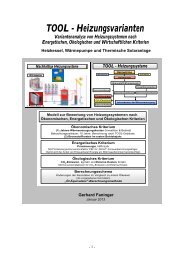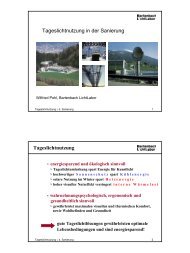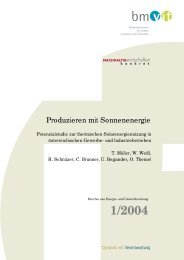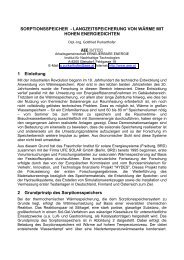Solar-supported heating networks in multi-storey residential buildings
Solar-supported heating networks in multi-storey residential buildings
Solar-supported heating networks in multi-storey residential buildings
Create successful ePaper yourself
Turn your PDF publications into a flip-book with our unique Google optimized e-Paper software.
3.1<br />
Low average collector temperatures as an energy-related success factor<br />
The average collector temperature ((T<strong>in</strong>let+Toutlet)/2) is the decisive value for the present high-quality<br />
collectors to atta<strong>in</strong> high solar yields throughout the year. The lower the average collector temperature,<br />
the higher the efficiency rate of the collector and thus the solar yield. Without a doubt, it is wrong to<br />
believe that the demand for the lowest possible average collector temperature can only be adequately<br />
achieved by the solar thermal system alone.<br />
It is rather the case that apart from the dimension<strong>in</strong>g of the collector area, other aspects and<br />
parameters determ<strong>in</strong>e the temperature level at the collector:<br />
• Type and manner of <strong>in</strong>tegration of the conventional heat generator<br />
• Pr<strong>in</strong>ciple and dimension<strong>in</strong>g of domestic water <strong>heat<strong>in</strong>g</strong><br />
• Pr<strong>in</strong>ciple and dimension<strong>in</strong>g of space <strong>heat<strong>in</strong>g</strong> supply<br />
• Dimension<strong>in</strong>g of the storage unit volume available for the solar thermal plant<br />
• Mix<strong>in</strong>g rate of energy storage unit (water amounts, geometries of storage units, etc.)<br />
The <strong>in</strong>fluence of the <strong>in</strong>teraction of the overall <strong>heat<strong>in</strong>g</strong> supply system on the average collector<br />
temperature, and thus on the efficiency of the collector, can be seen by way of example <strong>in</strong> Figure 6.<br />
Heat<strong>in</strong>g supply concepts adapted to the requirements of solar energy plants achieve much lower<br />
average collector temperatures and thus higher collector efficiencies <strong>in</strong> all operat<strong>in</strong>g po<strong>in</strong>ts.<br />
η 0<br />
1,00<br />
0,90<br />
0,80<br />
0,70<br />
0,60<br />
0,50<br />
0,40<br />
0,30<br />
0,20<br />
0,10<br />
A<br />
Collector Efficiency at Typical Operat<strong>in</strong>g Po<strong>in</strong>ts<br />
B<br />
0,00<br />
0,00 0,02 0,04 0,06 0,08<br />
(Tkm-Tu)/G [Km²/W]<br />
0,10 0,12 0,14 0,16<br />
11<br />
Conditions Given:<br />
Collector Data: c 0=0,8<br />
c 1=0.33 [W/m²K]<br />
c 2=0.012 [W/m²K²]<br />
Surround<strong>in</strong>g Temperature = 20 [°C]<br />
Average Collector Temperature A = 45 [K]<br />
Average Collector Temperature B = 60 [K]<br />
Radiation on the Collector Surface = 800 [W/m²]<br />
Figure 6: The <strong>in</strong>fluence of the temperature on the achievable collector efficiency. An Adapted holistic<br />
<strong>heat<strong>in</strong>g</strong> systems with lower mean temperature (operat<strong>in</strong>g po<strong>in</strong>t A) achieve essentially higher collector<br />
efficiency than for the example a solar thermal system with high return temperatures <strong>in</strong> the heat<br />
distribution system (operat<strong>in</strong>g po<strong>in</strong>t B).<br />
Only the <strong>in</strong>tegration of heat generators adapted to the needs of solar thermal systems or their heat<br />
emission components permits low average collector temperatures and thus the highest possible solar<br />
yields.














